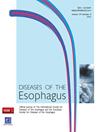776.食管癌三野淋巴结切除术:葡萄牙一家三级中心的经验
IF 2.3
3区 医学
Q3 GASTROENTEROLOGY & HEPATOLOGY
引用次数: 0
摘要
背景 美国癌症联合委员会(AJCC)和日本食管学会(JES)对食管癌的 N 分类有所不同,前者将锁骨上淋巴结出现病变视为 M1,后者则将其归类为胸部食管肿瘤的局部区域性病变。根据 AJCC 分类被排除在治愈性治疗策略之外的患者可能适合接受结节组 101 和 104(JES)的淋巴结切除手术。我们的目标是了解三野淋巴结切除术对食管癌患者的发病率、局部区域控制和总生存率的影响。方法 我们利用单个中心前瞻性数据库中的数据开展了一项回顾性队列研究,研究对象包括 2019 年 1 月至 2023 年 12 月期间接受食管癌切除术并行两野全胸淋巴结切除术或三野淋巴结切除术的所有连续患者。三野淋巴结切除术适用于临床锁骨上和返神经结节受累以及近端第三肿瘤。我们评估了两种手术的发病率和死亡率,以及两组患者的局部区域和远处复发率及总生存率。结果 在 279 例食管癌切除术中,有 137 例被纳入分析范围。中位年龄为 65 岁,男性占 84%。58.4%为鳞癌,41.6%为腺癌。34.3%的患者进行了三野淋巴结切除术,其中27.7%为锁骨上N+淋巴结切除术,34%为返神经N+淋巴结切除术。结论 在这个大型单中心队列中,有明显淋巴结受累的患者在接受食管切除术和三野淋巴结切除术治疗后,其局部区域控制率和总生存率与较好的病例相当,发病率和死亡率没有统计学意义上的显著增加。本文章由计算机程序翻译,如有差异,请以英文原文为准。
776. THREE-FIELD LYMPHADENECTOMY IN ESOPHAGEAL CANCER: EXPERIENCE OF A PORTUGUESE TERTIARY CENTER
Background The American Joint Committee for Cancer (AJCC) and the Japanese Esophagus Society (JES) differ in the N classification for esophageal cancer, with the former considering the presence of disease in the supraclavicular lymph nodes as M1, and the latter classifying it as loco-regional disease in thoracic esophageal tumors. Patients who would be excluded from a curative intent treatment strategy by the AJCC classification may be candidates for surgery with lymphadenectomy of nodal groups 101 and 104 (JES). Our goal is to understand the impact of three-field lymphadenectomy on morbidity, loco-regional control and overall survival in patients with esophageal cancer. Methods A retrospective cohort study was conducted using data from a prospective database from a single center, which included all consecutive patients undergoing esophagectomy for cancer with either two-field total thoracic lymphadenectomy or three-field lymphadenectomy, between January 2019 and December 2023. Three-field lymphadenectomy was performed for clinical supraclavicular and recurrent nerve nodal involvement and for proximal third tumors. We assessed the morbidity and mortality of both types of surgery, and loco-regional and distant recurrence and overall survival for both groups. Results Of the 279 esophagectomies for cancer, 137 were included for analysis. The median age was 65 years, with 84% males. 58,4% had squamous cell carcinoma and 41,6% adenocarcinoma. 34.3% of the patients had a 3-field lymphadenectomy, 27,7% of these for supraclavicular N+ and 34% for recurrent nerve N+. Conclusion In this large single-center cohort, patients with significant lymph node involvement, treated with esophagectomy and three-field lymphadenectomy, demonstrated comparable loco-regional control and overall survival to more favorable cases, with no statistically significant increase in morbidity and mortality.
求助全文
通过发布文献求助,成功后即可免费获取论文全文。
去求助
来源期刊

Diseases of the Esophagus
医学-胃肠肝病学
CiteScore
5.30
自引率
7.70%
发文量
568
审稿时长
6 months
期刊介绍:
Diseases of the Esophagus covers all aspects of the esophagus - etiology, investigation and diagnosis, and both medical and surgical treatment.
 求助内容:
求助内容: 应助结果提醒方式:
应助结果提醒方式:


